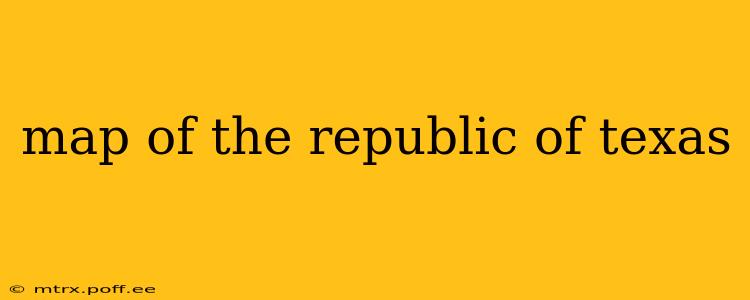The Republic of Texas, a short-lived but impactful nation, held a unique place in North American history. Understanding its geographical boundaries requires more than just a glance at a modern map; it necessitates delving into the complexities of its claims, treaties, and ultimately, its annexation by the United States. This exploration will delve into the intricacies of the Republic of Texas's map, addressing common questions and providing a deeper understanding of its territorial extent.
What were the boundaries of the Republic of Texas?
The boundaries of the Republic of Texas were a subject of considerable debate and contention throughout its existence (1836-1845). The claimed territory was significantly larger than the area eventually incorporated into the United States as the state of Texas. The Republic claimed land stretching from the Sabine River in the east to the Rio Grande River in the west, and from the Gulf of Mexico in the south to an undefined northern boundary, often loosely described as the 42nd parallel (though this was never definitively established). This vast territory encompassed significant portions of present-day New Mexico, Oklahoma, Kansas, Colorado, and even parts of Wyoming. Mexico, however, never recognized these expansive claims.
What is the difference between the claimed territory and the actual territory controlled by the Republic of Texas?
This is a crucial distinction. While the Republic claimed the vast territory described above, it didn't effectively control all of it. The Republic's military and administrative reach was significantly limited. Effective control was largely confined to the eastern and central portions of the claimed territory, with influence waning considerably in the sparsely populated western regions. The vast expanse of the claimed territory posed significant challenges in terms of governance, defense, and resource management. Conflicts with Native American tribes and ongoing disputes with Mexico further limited the Republic's practical control.
How did the boundaries of the Republic of Texas compare to modern-day state boundaries?
The modern-day state of Texas occupies a significantly smaller area than the Republic's claimed territory. The western boundary, a major point of contention with Mexico, was a key factor in the Mexican-American War. The northern boundary remained largely undefined and disputed throughout the Republic's existence. The eastern boundary followed the Sabine River, relatively consistent with the current state's boundary. The southern boundary, along the Gulf Coast, aligns closely with the present-day state's coastline.
Why were the boundaries of the Republic of Texas so important?
The boundaries of the Republic of Texas were central to its survival and future. These boundaries held significant economic implications, encompassing vast land resources and potential mineral wealth. Control over these resources was vital for the Republic's economic viability and independence. Furthermore, the ambiguity and disputes over the boundaries were major sources of conflict with both Mexico and the United States, significantly impacting the Republic's foreign relations and ultimately its absorption into the United States.
Did the Republic of Texas ever officially define its northern boundary?
No, the Republic of Texas never officially defined its northern boundary. This lack of clarity contributed significantly to ongoing disputes and uncertainties regarding its territorial extent. Various proposals and claims were made, but no universally accepted northern boundary was ever established during the Republic's short existence. This ambiguity further complicated its annexation by the United States, which ultimately settled the matter through subsequent treaties and legislation.
The map of the Republic of Texas is more than just a geographical representation; it’s a testament to a complex period in American history, shaped by ambition, conflict, and the ultimately unresolved questions of territorial sovereignty. Understanding these boundaries requires careful consideration of the Republic's claims, its limitations, and its legacy within the broader context of westward expansion and the formation of the United States.
